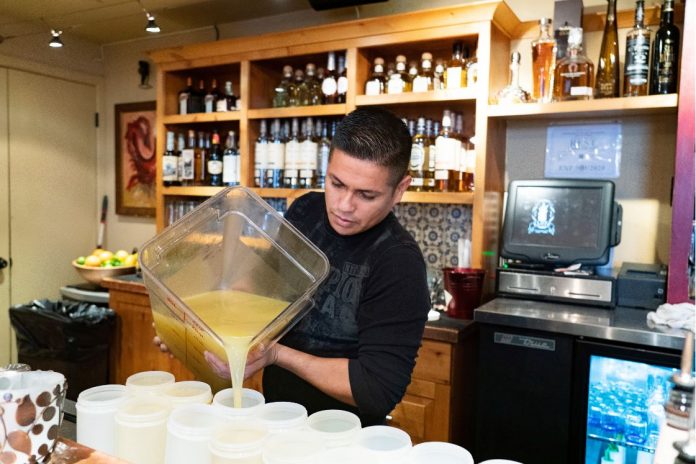Besides a new year and a new decade, Jan. 1 was also the start of a new minimum wage for many Arizonans. The $1 increase to $12 an hour means an extra $8 of spending money for employees per eight-hour day, $40 per work week and $160 per month, before taxes and other deductions. But that same amount of extra cash for employees means less for employers, who often have to reallocate business funds by raising merchandise prices or lowering their quality, reducing hours the employees work or even letting some staff go.
Still, the $1,920 pre-taxed monthly income that minimum wage earning, full-time employees now make is not enough to rent a studio or one-bedroom apartment in the area.
Kristen Stambaugh, who makes $3 more than the minimum wage as a manager at Sedona Artwear & Shirt Company in Uptown, laughed at the prospect of living in the same town that her job is located. Like many young workers in Sedona, she commutes from Cottonwood.
“I can’t afford to live here. I’m young, I don’t have enough credit. And even trailers here are like $2,000 [per month],” Stambaugh said. “It’s not like the old days. The old days you could do anything. Buy a house, buy a car. Do whatever you want.”
Stambaugh said that the retail shop earns enough in sales that the increase in minimum wage hasn’t affected their business.
“We haven’t had to raise any prices,” she said.
However, Stambaugh runs the shop mainly solo through the “dead” season from November to around February. For the spring, when the tourists come in droves, they hire four to five temporary workers, she said.
Last spring, when the minimum wage was still $11 an hour, Stambaugh said the seasonal workers were already making $12 an hour — a trend that wasn’t unique among many Uptown stores.
Robben Baker, 24, has worked at Chipotle for three years and been a manager for most of that time. Not long after he started in 2017 [when the Arizona minimum wage was $10 an hour] he started getting $12 an hour along with the other employees.
“We’ve already been ahead of the curve on that,” Baker said. “I think it’s mostly because the demographic we have to hire from — most of our employees come from Cottonwood, which is a long commute — already have a lot of job opportunities over there, so to get them over here we kind of need the enticement of the higher wage.”
Baker commutes daily from Flagstaff, where he said he chooses to live, with roommates, not only because it’s easier to find more affordable housing, but also because there are more people around his age.
With many employees already making $12 an hour at the time of this year’s minimum wage switch, employers are faced with a dilemma: If some of their employees get an automatic raise to $12, what about the ones who were already making $12 an hour due to merit or experience?
While it is not a legal requirement, many local employers boost the wages of the more experienced workers along with the ones getting the new minimum wages.
Other employers would like to raise all their workers’ wages, but simply can’t afford it — especially those with many employees. Bill Barnes, manager of the Cold Stone Creamery, said he has fewer workers than when he opened 11 years ago, and he works more hours to make up for it.
“We’ve been here 15 years. Four years ago [the minimum wage] was $8 an hour. Now it’s $12,” he said.
Barnes said he is having to look into increasing his prices for the franchise to stay afloat.
“I decided to look at the other stores around here and make [the prices] comparable to what they are. The average for an ice cream store for the small size is $5. So we’re at $4.69,” Barnes said, adding that he may start also charging a dollar per ounce.
Besides a possible products price raise and having to work more himself, Barnes shared the sentiment that not all employees’ work is equal to a $12 standard, especially if they are brand new.
“I started to pay somebody that much to sit here and not do nothing,” he said.
The automatic raises make performance-based raises obsolete, some business owners said, adding that it’s hard to find motivated employees and there is no room in the payroll to reward the ones who are.
Other employers said paying a competitive wage is well worth the sacrifice.
“The minimum wage increase is perfectly reasonable,” Synergy Lounge & Kitchen owner Sierra Shafer wrote in an email. “Sometimes it is difficult to afford great wages as a small start-up business, but truly good help is absolutely the most valuable asset to any business and worth the price.”
Shafer said that she will be giving a raise to $13 an hour for her front of the house staff, who also get heavy discounts on the organic coffee, chocolate and herbal remedies sold at the shop.
“My employees make more per hour spent on the business than I do, that’s for sure … but they are absolutely essential and you’ve got to support them so they can keep coming back and supporting you. It’s a classic, essential exchange,” she said.
Jeff Smedstad, owner and chef of Elote Café, also makes it a priority to make sure his staff get more than the minimum wage.
For restaurants where servers are tipped, waitstaff can have a base pay of $3 less than the minimum wage — $9 this year in Arizona — because the money they get in tips makes up for the difference.
In Elote’s case, tips servers get far outweigh minimum wage.
Elote’s bussers, dishwashers and non-directly tipped employees also get a share of the servers’ tips. Additionally, Smedstad gives bonuses on good nights.
“That comes out of my pocket but that’s fine, I don’t mind,” Smedstad said. “That’s my way of making sure that they participate in the success of the restaurant as well.”
Smedstad also noted the extra cash helps with the high cost of living in Sedona and the VOC, but said only about 20% of his employees actually live in the area.
Assistant Sedona City Manager Karen Osburn wrote in an email that “The City Council has not discussed the minimum wage as a local policy issue nor sought to regulate minimum wages at the local level.”
However, she added that the city is focused on making “affordable housing as one of its policy priorities in recognition that the area’s high housing prices make both renting and owning out of reach for many of Sedona’s workforce, particularly those earning the lowest wages.”
The city has conducted a comprehensive housing survey and should have the preliminary data by February, with the findings and recommendations



















